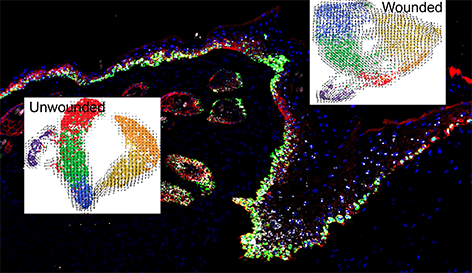“This study is the first comprehensive dissection of the major changes in cellular heterogeneity from a normal state to wound healing in skin,” said Xing Dai, PhD, a professor of biological chemistry and dermatology in the UCI School of Medicine, and senior author. “This work also showcases the collaborative efforts between biologists, mathematician and physicists at UCI, with support from the National Institute of Arthritis & Musculoskeletal & Skin Diseases-funded UCI Skin Biology Resource-based Center and the NSF-Simons Center for Multiscale Cell Fate Research.
The study, titled, “Defining epidermal basal cell states during skin homeostasis and wound healing using single-cell transcriptomics,” was published this week in Cell Reports.
“Our research uncovered at least four distinct transcriptional states in the epidermal basal layer as part of a ‘hierarchical-lineage’ model of the epidermal homeostasis, or stable state of the skin, clarifying a long-term debate in the skin stem cell field,” said Dai.
Using single-cell RNA sequencing coupled with RNAScope and fluorescence lifetime imaging, the team identified three non-proliferative and one proliferative basal cell state in homeostatic skin that differ in metabolic preference and become spatially partitioned during wound re-epithelialization, which is the process by which the skin and mucous membranes replace superficial epithelial cells damaged or lost in a wound.
Epithelial tissue maintenance is driven by resident stem cells, the proliferation and differentiation dynamics of which need to be tailored to the tissue’s homeostatic and regenerative needs. However, our understanding of tissue-specific cellular dynamics in vivo at single-cell and tissue scales is often very limited.
“Our study lays a foundation for future investigation into the adult epidermis, specifically how the skin is maintained and how it can robustly regenerate itself upon injury,” said Dai.
This study was supported in part by the National Institutes of Health, the National Science Foundation and the Simons Foundation.
About the UCI School of Medicine
Each year, the UCI School of Medicine educates more than 400 medical students, and nearly 150 doctoral and master’s students. More than 700 residents and fellows are trained at UCI Medical Center and affiliated institutions. The School of Medicine offers an MD; a dual MD/PhD medical scientist training program; and PhDs and master’s degrees in anatomy and neurobiology, biomedical sciences, genetic counseling, epidemiology, environmental health sciences, pathology, pharmacology, physiology and biophysics, and translational sciences. Medical students also may pursue an MD/MBA, an MD/master’s in public health, or an MD/master’s degree through one of three mission-based programs: the Health Education to Advance Leaders in Integrative Medicine (HEAL-IM), the Leadership Education to Advance Diversity-African, Black and Caribbean (LEAD-ABC), and the Program in Medical Education for the Latino Community (PRIME-LC). The UCI School of Medicine is accredited by the Liaison Committee on Medical Accreditation and ranks among the top 50 nationwide for research. For more information, visit som.uci.edu.
Original post https://alertarticles.info


